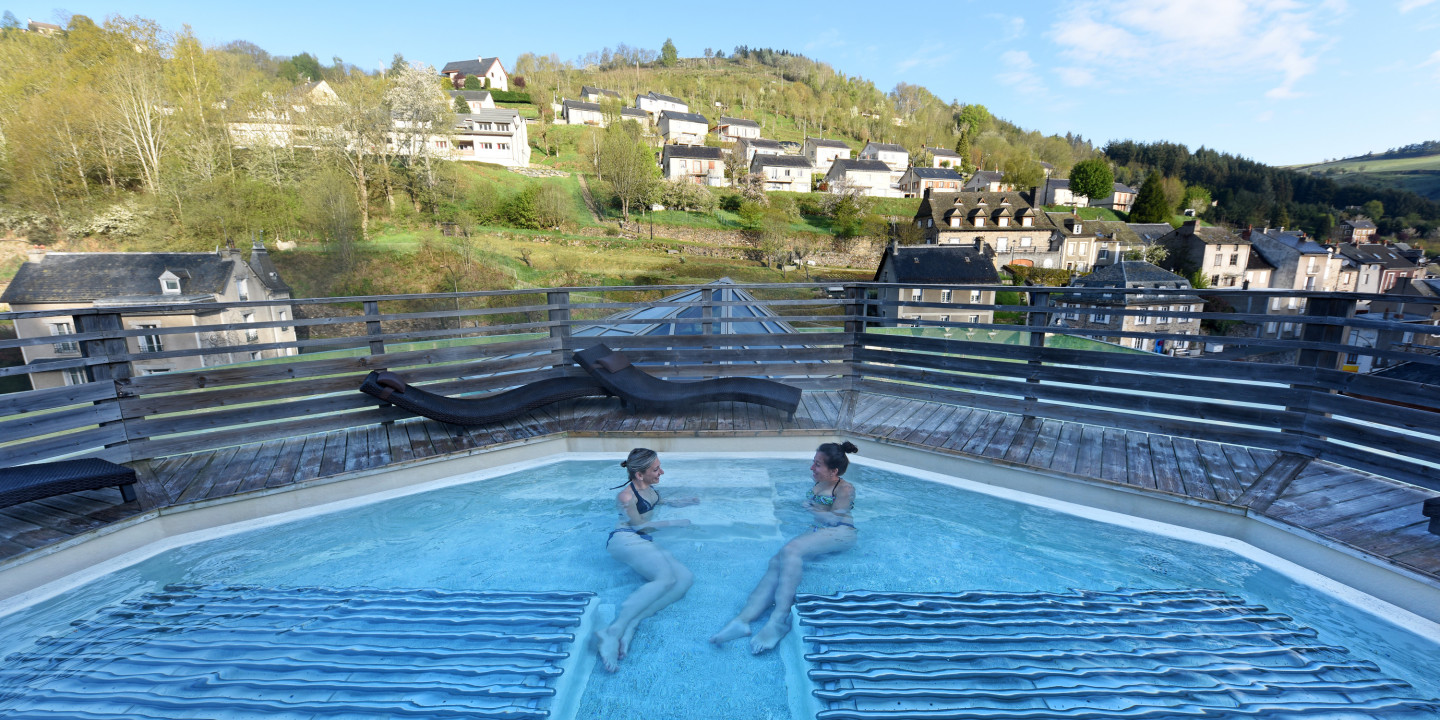CALEDEN : The Only Thermal Spa in Cantal
Nestled within the historic site of the former Chaudes-Aigues thermal baths, Caleden stands as a modestly sized thermal station. It combines the once-separate thermal establishments of Ban and Par into the new Caleden thermal complex.
Caleden offers a comprehensive range of thermal treatments and wellness experiences utilizing thermal water. The center spans multiple levels: the Caleden Thermalism area is specifically tailored for treating rheumatic conditions and post-traumatic sequelae, while Caleden Spa provides massages, exfoliation treatments, and various aesthetic services.
The Thermal Resort of Chaudes-Aigues: A unique wellness destination
Chaudes-Aigues, located in the Cantal region, is renowned for being Europe’s warmest spa resort. Its water, from natural sources, reaches an exceptional temperature of up to 82°C, especially with the famous source of Par, used since antiquity for its therapeutic virtues.
Why visit the spa of Chaudes-Aigues?
Waters with recognized benefits
The thermal waters of Chaudes-Aigues are rich in minerals and trace elements, including sulphur and sodium. They are particularly recommended for relieving rheumatism, joint and muscle pain.
A modern spa: Caleden
The Caleden centre offers spa treatments, medical cures and a wellness area with thermal pools, hot tubs, saunas and steam baths. Whether you are looking for a therapeutic cure or simply a moment of relaxation, Caleden is the ideal place.
A fascinating thermal heritage
Beyond the benefits of water, Chaudes-Aigues has a unique heritage. The village developed around its hot springs, which were even used for heating houses from the Middle Ages, an ingenious system still visible today.
A rejuvenating natural setting
Nestled in the mountains of Cantal, Chaudes-Aigues offers a quiet and unspoilt environment, ideal for a wellness getaway. After a session at the spa, you can go hiking and discover the volcanic landscapes of the region.
Whether for a spa treatment, a relaxing break or a historical discovery, Chaudes-Aigues is an essential destination of thermal tourism in Auvergne.
The origin of the thermal water of Chaudes-Aigues
The thermal water of Chaudes-Aigues comes from a natural geothermal phenomenon that takes place deep under the earth’s crust. Its origin dates back several thousand years and results from a long natural process.
1. Infiltration of rainwater
Thermal water begins its journey as precipitation (rain or snow) which slowly infiltrate the soil through permeable rocks. It then descends to a depth of 2,500 metres.
2. Warming in the Earth’s depths
At this depth, the natural heat of the subsoil, due to the region’s ancient geothermal and volcanic activity, warms the water. This phenomenon is explained by the fact that the earth’s temperature increases on average by 30°C every 1000 metres (geothermal gradient). The water reaches a temperature of almost 82°C, making it one of the hottest in Europe.
3. Rising hot water
Under pressure, water gradually rises to the surface through geological faults and rock fractures. This pathway allows water to charge up minerals and trace elements such as sulphur, sodium and calcium, which gives it its therapeutic properties.
4. The emergence of sources
The thermal water springs naturally to the surface in the form of hot springs, the most famous being the source of the Par, with a temperature of up to 82°C. This water has been used since antiquity for its health benefits and even to heat some houses in the village thanks to an ingenious network of pipes.
This natural process, which takes several thousand years, makes Chaudes-Aigues a unique thermal site where water from the earth’s depths offers a well-being and care experience recognized for centuries.
An unusual anecdote about the thermal water of Chaudes-Aigues
The boiling water of the Aigues-Chaudes springs has long been a precious resource for the inhabitants... and not only for thermalism!
In the Middle Ages, villagers found a surprising use for this water at 82°C: they used it to cook their food. It is said that some people dipped their eggs directly in the gutters where the hot water flowed to cook them with a shell without using fire!
Another unusual use: the natural boiler house. Long before the arrival of central heating, a network of wooden and stone pipes distributed thermal water under some houses, warming floors and walls in winter. This natural district heating system, called "Caldarium", was a real technical feat and made Chaudes-Aigues a city ahead of its time.
Even today, this exceptionally warm water continues to be exploited, whether for the well-being of spa guests or to preserve this unique local tradition!
Visit the Geothermal Museum after a relaxing time at the thermal baths
After relaxing in the spas of Chaudes-Aigues, why not extend the experience by discovering the fascinating history of the warm waters that make the village famous?
The Museum of Geothermal and Thermalism immerses you in the unique world of this exceptional natural resource. You will learn how, since ancient times, the inhabitants exploited these natural hot springs, reaching 82°C, for heating, care and daily life. Models, historical documents and interactive animations explain how Chaudes-Aigues became the first city in Europe to use a geothermal district heating network as early as the Middle Ages.
This is an ideal visit to understand the benefits of thermal waters while discovering the human ingenuity that has allowed them to be exploited over the centuries. A great way to complete your wellness day while enriching your knowledge!
How to get to Les Chaudes-Aigue from the Laussac peninsula?
To get from the Laussac peninsula to Chaudes-Aigues, here is a suggested route:
From the peninsula of Laussac, take the D34 road towards Thérondels.
In Thérondels, continue on the D18 towards Brommat.
In Brommat, follow the D900 towards Laguiole.
From Laguiole, take the D921 towards Chaudes-Aigues.
